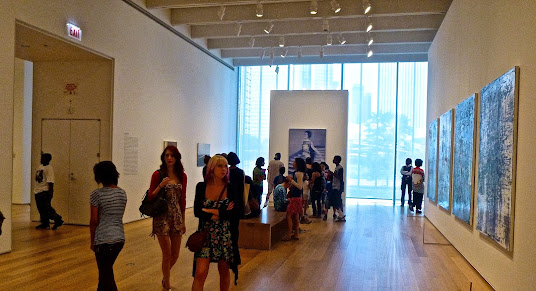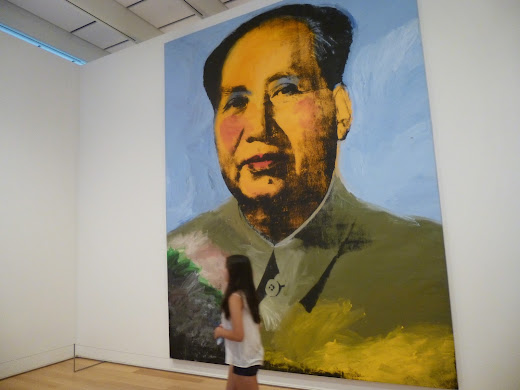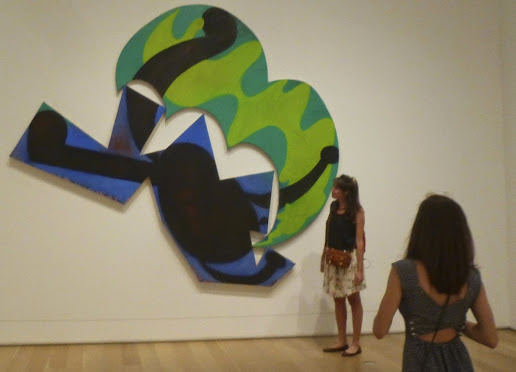(Drivebycuriosity) - Chicago has 2 awesome museums: The Art Institute Chicago and the Museum of Contemporary Art. Recently - as my wife and I revisited the midwestern metropolis - we went to the Art Institute again which we have seen last year (driveby). This time we focused on their amazing collection of contemporary art past 1965 (artic).
My favorite of the represented artists there is Gerhard Richter, who has a room for his own. There you can see why the German painter is the highest valued living artist as measured against the auctions revenus of his works (wikipedia). His paintings combine imagination with superb technical qualities. His art "ranges freely over an astonishing variety of seemingly contradictory modes and genres" report the curators of this exhibition.
His "Woman Descending the Staircase" (Oil on canvas) looks from far like a photography, but when you come closer you can see the delicate brush strokes. The painting, created 1965, belongs to the artist`s early works when he enlarged and transferred photographs such as personal snapshots or images drawn from newspapers and magazines. He then blurred the images by dragging a dry brush over wet pigment.
Richter`s paintings "Flowers", "Two Candles" and "Little Landscape at the Seascape" (all oil on canvas) - shown above - are also a result of this technique.
The "Mouth" (Oil on canvas), which looks less natural, gives a glimpse on Richter´s imagination. The painting, one of the artist´s earliest surving canvases (early 1960s), is derived from an image of the French actress Brigitte Bardot. It looks like as she wants to suck you in.
Above you can see Richter`s "Ice" ("Eis") 1,2,3 & 4. In each of his four paintings the artist built up the surface with multiple layers of paint, laid on with alternating horizontal and vertical strokes (pulls) of a scraper. Each pull added a film of pigment but in places also dragged up one or more underlying layers. Richter himself had characterized his abstract paintings as constructions rather as expressions.
Besides Richter you can find a lot of gorgeous works from other important artists there:
Fethististic Fragmentation
Christina Ramberg (1946-19959) was part of the Chicago Imagists. Her paintings frequently present the female figure in pieces. The visual impact of her fethististic fragmentation of the body`s heigthened through a meticulous attention to the painted surface. Above you can see "Loose Beauty" (Acrylic on board) The painting displays "the textual interplay between the figure`s smooth flesh and alternately slick and scalloped undergarments that calls attention to a duality of pleasurable sensuality and disciplining constraints", comment the curators.
Philip Guston`s paintings are influenced by comic strips, politics and his personal problems. Above you can see "Green Sea" and "Red Box" (Oil on canvas). In "Red Box" an outstretched arm drives the last nail into Guston´s own imagined coffin. Sounds depressive and grizzly, but looks funny, anyway. Maybe the artist made fun of his own depressions, a kind of autotherapy.
Jim Dine`s work, "Green Suit" (Corduroy suit, corrugated cupboard, wire and oil paint) reminds me a bit of the German artist Josepf Beus who created a famous sleaze suit. For creating this art work the performance artist used clothing taken from his own closet. I am not sure if Dine used this suit for his own performance events and happenings.
Robert Rauschenberg is famous as co-founder of pop-art. His "Persimmon" (Oil paint and silkscreen ink on canvas) is a kind of detour into the renaissance, maybe he wanted to show his classical skills and his knowledge. Anyway, the painting above combines objects - dishes and fruit - with a detail from Peter Paul Ruben`s "Venus in front of the Mirror" from 1613/14.
Ed Ruscha, the creator of the painting "City" (Oil on canvas), shows an interest in the visual and conceptual tensions between text and image. The image above is part of a series of "liquid" or "wet" word paintings, in which the linguistic effect is made more palpable by the trompe l'oeil renderings of the words, which suggests that they have been created from water, oil, syrup or another fluid.
Vija Celmins` "Explosion at Sea" (Oil on canvas) is one of these paintings which can be confused with a photography on the first view. I am impressed by the technical skills this picture reveals. Celmins used photographs from books, magazines and newspapers found at secondhand stores and yard sales as departure of her work. The painting aboves shows a detailed image of an attack on an aircraft carrier.
Lee Bontecou uses waste as base for her works like used conveyor belts discarded by a neighboring laundry. Above you can see "Untitled" (Steel, canvas, and copper wire) where fragments of natural canvas and burlap are tautly stretched and attached with wire to an armature and welded frameworks. Every elements seems directed toward the deep, velvet-lined opening - a mysterious hole. You can speculate what you see: Is it a bizarre crater in Siberia, a black hole ore something anal, like a human sphincter?
Hidden Realities
Glady Nilson`s, The Trogens (Acrylic on plexiglas) shows the artist´s interest in the themes of hidden realities. The painting above recalls the iconic story of the Trojan Horse from Homer`s "The Odissey", suggesting that artifice can belie true meaning and that things are not always as they appear.
Jo Baer composed her work "Memorial for an Art World Body (Nevermore)" (Oil on canvas) after her own biography. She layered preexisting imagery to map her own life´s cycle. The starry backround depicts the constellations visible visible in the sky at the moment of her birth. The central figure of the artist as a young woman derives from a snapshot taken by an admirer. The stiff figures standing in rows were reclaimed from paintings of Baer by her ex-husband John Wesley, a pop artist, who despicted her as kourai, ancient Greek statuary. These idealized images of Baer in her youth are countered by the potrayal of her as an ominous bird, taken from a painting by Bruce Robbins, and of ravens peering over a golden Egyptian sarcophagus. She must loved herself very much, but I think the picture has its charm anyway.
I think Sylvia Plimack Mangold`s "In Memory of My Father "(Acrylic on canvas) is somewhat funny. Maybe the artist had a very austere and meticulous parent whom she wanted to erect a memorial. Btw. the measurement stick in the painting above stops on the right edge of the canvas at 66 3/4 inches, which correspondents to the age of the artist`s father upon his death.
Ellsworth Kelly aimed to investigate "how things look". His work "emphazise pure line, form and color and his abstraction is rooted in observed visual phenomena in natural and manmade enviroments" say the curators. Here you can see his painting "Black and White" (Oil on canvas).
Roy Lichtenstein is famous for his cartoon like paintings, the so-called pop art. It looks like that he made sometimes fun of his artist colleagues who focused on abstract and expressionistic pictures as his "Brushstroke with Spatter"(Oil and magna on canvas) above this paragraph shows.
The Art Institute has "an" Andy Warhol, of course. This iconic artist employed a lot of busy technicians, his famous "Factory", which produced tons of art work which is now spreaded all over the world. His "Mao" (Synthetic polymer paint and silk screen ink on canvas) - who fills a whole wall - is really impressive. But - this huge Mao portrait raises the question: How come a dictator and murderer of millions of people still has the status as a pop icon? Maybe his victims don´t have a powerful lobby?
Elizabeth Murray´s work playes with influences by Cubism, Abstract Expressionism and comic art. Her you can see her "Back on Earth" (Oil on two canvases).
Unfortunately my point-and-shoot camera doesn´t capture the paintings very acurately; they are just proxies. If you like the pictures, you might visit the Art Institute by yourself.
Enjoy!







































No comments:
Post a Comment